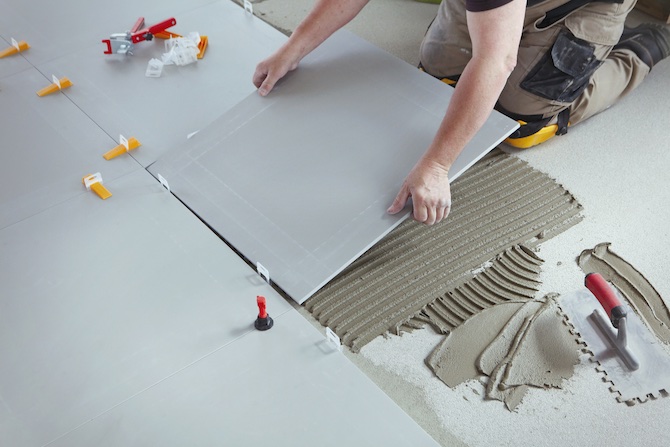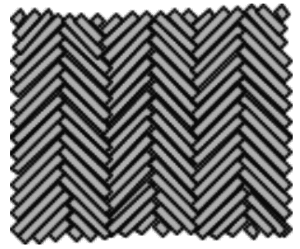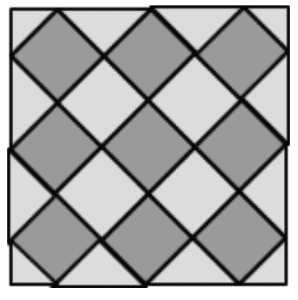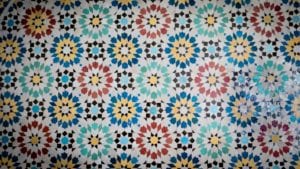tile-setting
That your tiles sit neatly and tightly on the wall is important. You don’t want to look at crooked tiles for years, do you? On this page, you will find more information about tiling costs, the working methods of tilers and the possibilities.
What are the costs of tiling?
Hiring a tiler does not have to be expensive. On average, it costs between £25 and £40 per m². The final cost of laying tiles depends on your preferences and chosen material.
| Factors | Average price per m² |
|---|---|
| Tile laying | £ 25 – £ 40 |
| Tiles | £ 15 – £ 160 |
| Materials (glue, grout, etc.) | £ 10 – £ 20 |
| Total | £ 50 – £ 220 |
Find the best specialist for your project and get free quotes.
Start

Tile types
The two most common types of tiles are ceramic tiles and natural stone. Both tiles come in different sizes, thicknesses and colours. A ceramic tile is created by firing earth. A glaze layer determines the colour and pattern of the tile. Natural stones are formed by nature. Unlike ceramic tiles, no two natural stones are the same.
| Advantages | Advantages | |
|---|---|---|
| Ceramic tiles | – Low maintenance – Highly resistant to chemicals – Scratch-, stain, and impact resistant |
– Scratches stand out quickly – Ceramic tiles have a cold feel |
| Natural stone | – Unique character, each stone is different – Damage is less likely to be noticed |
– Chance of imperfections – Sensitive to chemicals |
Below you will read more about the advantages and disadvantages of some material types and find more information on tile maintenance.
Ceramic tiles
Applications of ceramic tiles
Would you like ceramic tiles laid as floor tiles in your kitchen or living room? Then choose grey tiles. These tiles contain minerals that strengthen the tile. Wall tiles do not need to be as strong. Faience tiles are then recommended. Faience tiles are fired earth tiles with a glazed coating. Remember that the tiles need extra treatment in damp areas in your home. This way, they do not let moisture pass through. Do you lay the tiles on the ground? Then make sure they get a non-slip coating.
Advantages of ceramic tiles
Ceramic tiles are maintenance-free. This is a big advantage. Glazed tiles are highly resistant to chemicals and are scratch, stain, and impact resistant.
Disadvantages of ceramic tiles
A scratch on ceramic tiles is very visible. With deep scratches, the underlayment comes to the surface. In addition, compared to laminate and wooden floors, ceramic tiles can feel very cold.
Maintenance of ceramic tiles
A ceramic tile, as mentioned, requires little maintenance. Using as neutral a cleaner as possible without acids and oil is important when cleaning the tiles. Oil can form a layer on your tiles that is difficult to remove.
Natural stone
Applications of natural stone
Natural stone can give your home a unique character. If you put natural stones in your living room or bedroom, make sure you get polished stones. Polished stones wear out less quickly. If you lay natural stones in a damp room, it is important to impregnate them. This is because impregnated natural stone is more resistant to moisture and dirt.
Advantages of natural stone
Natural stones are durable. Natural stone retains heat well and is suitable for underfloor heating. In addition, natural stone has a unique character. Every natural stone is different. This makes damage less noticeable. Moreover, the damage is less noticeable as the stone does not change colour.
Disadvantages of natural stone
With natural stone, remember that there are imperfections in the stone. After all, natural stone remains a natural product. In addition, natural stones are sensitive to acids and chemicals.
Maintenance of natural stone
Natural stones need more attention due to the open pores. It is important to impregnate the tiles. This way, not all the dirt and liquid absorb into the stone’s pores. After impregnation, the natural stones have a longer life and are easier to clean.

Laying bond
Tile setters know many laying bonds. Some laying patterns make rooms appear larger. Others give a room a rural feel. Laying tiles can be very complex. Specialists can create the effect you want. Check out the different laying patterns here.
| Semi-brick bond | Semi-brick bond is similar to the way bricks are laid. The courses lie in one straight line, giving the room a lively look. Half-brick bond is one of the most commonly chosen laying patterns. |  |
| Dambord pattern | A checkerboard pattern is one of the simplest patterns. The tiles are laid right next to and on top of each other. A checkerboard pattern is created by using 2 different colours. |  |
| Wildborder | To get a wildborder pattern, several sizes of tiles are needed. This is a specialised task where the tiler can show his skills. A wildbond creates a unique look because of the artificial patterns. |  |
| Block bond | The block bond is often used in gardens due to the use of clinkers. Laying two oblong tiles next to each other creates a square. Of course, this bond is perfectly applicable indoors. |  |
| Visguette bond | Visguette bond is very popular in old streets. You see this pattern more and more indoors. Long narrow tiles give your kitchen and bathroom a whole new look. |  |
| Diagonal bond | Tiles in a diagonal bond are rotated 45 degrees. Setting tiles in a diagonal bond makes the room appear larger. The tiler has to do more chopping with this bond. The tiler cuts the tiles at corners and edges, leaving more tile waste. |  |
Tile setters
A tiler takes a lot of work off your hands. The tiler prevents your back from suffering for days and provides quick and beautiful tiling. When choosing a tiller, there are many things to consider. See if the tiler charges call-out fees and offers a guarantee. Ask the tiler what types of stone and laying patterns he specialises in. And agree with the tiler on how the price is determined. Does he charge per square metre or hour? You can find the tiler with the best price-quality ratio by comparing quotations.
The procedure of a tiler
Tiling is a specialist job. Tiling a toilet takes the specialist at least 1 day. An average bathroom quickly takes 2-3 working days. Remember that showering at home will not be possible for a few days. A professional tiler first ensures the surface is dry and grease-free. That way, the glue will stick properly. Have you chosen your laying pattern? The specialist will then start the tiling work. After drying for 24 hours, the tiler will apply sealant. Sealant provides a nice finish and prevents moisture behind the tiles.
Self tiling
Tiling is very tricky. You might get a long way thanks to instructions via internet videos and reading through manuals. But suppose something goes wrong? Who will sort it out? And how are you insured? A tiler has years of experience and knows exactly what difficulties you might encounter. So have the work done by a specialist. This will give you a smooth wall you will enjoy for years.
Tile inspiration
Tiles are everywhere in your home. From tiny mosaic tiles to tiles measuring a metre by metre. Do you want high-gloss or matt tiles? Go for matt tiles if you want to keep it basic. Choose glossy tiles for a luxurious look.
Kitchen tiles
Kitchen tiles determine the look of your kitchen. Do you go for large plain tiles? Then you will get a modern look. Do you want an authentic kitchen? Then choose small design tiles. Tiles in the kitchen have the added advantage that the back wall can be cleaned quickly. Dirt and grease can be removed immediately with a damp cloth. Floor tiles in the kitchen are handy. Something that falls on the floor is cleaned up in no time.
Bathroom tiles
Tiles are very suitable for bathrooms. In addition, bathroom tiles create a calm atmosphere. Want to make your bathroom look more spacious? Then buy large bathroom tiles. Combine different sizes, colours and patterns of tiles for a unique bathroom.
Moroccan and Portuguese tiles
Moroccan tiles create a unique atmosphere. Each tile is different and handmade. Imperfection is characteristic of Moroccan tiles. They are suitable for any room indoors and outdoors. Moroccan tiles are suitable for creating a ‘lived-in’ look.

Portuguese tiles are known for their authentic patterns. The small tiles that combine to form a large detailed pattern are often used in halls. Of course, Portuguese tiles can also serve as kitchen tiles and bathroom tiles. Portuguese tiles are even suitable for lining your stair.

Tips on tiling
- Skilled tiling – Tiles last a long time if they are professionally installed. Specialists ensure a tight fit. This prevents moisture in the wall. Keeping tiles and grouting clean keeps them looking great for years after installation.
- Joint colour – Give joints the same colour as the tiles. This creates a calm and clean look.
- Large tiles – Smaller rooms can appear larger by using large tiles. Let the floor tiles continue on the wall. Tiles with a light colour create a spatial effect.
- Floor heating – Tiles are great for getting your room radiator free. Tiles are very good heat conductors. You can still get a warm room by putting underfloor heating under the tiles.
- Tile fitters – Get several quotes from tile fitters. As well as the price, compare the cost of removing the old tiles, call-out charges, quality marks and delivery time.
Find the best specialist for your project and get free quotes.
Start